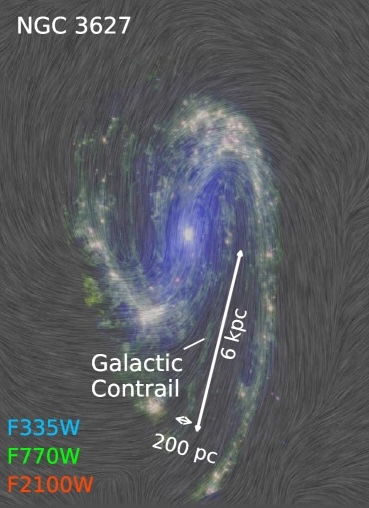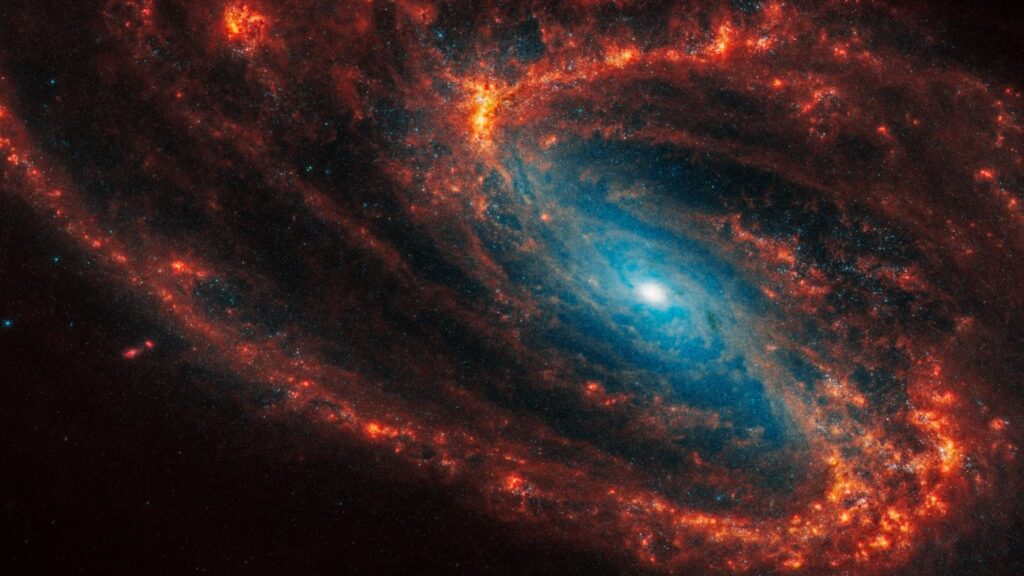Astronomers have observed a giant cosmic “contrail” in a distant galaxy. The gas and dust signatures may have been produced in large quantities by a passing supermassive black hole, but there are other possible causes, scientists report in a new study.
The contrail was discovered in the spiral galaxy NGC 3627, about 31 light-years from our solar system in the constellation Leo.
you may like
Zhao and co-author Guang-Xing Li encountered the galactic contrail while analyzing data collected by the High-Angle-Resolution Physics of Nearby Galaxies (PHANGS) survey. This study aims to use a variety of telescopes, including the James Webb Space Telescope (JWST) and the Atacama Large Millimeter/Submillimeter Array (ALMA) in Chile, to study how gas and star formation affect and are influenced by the structure and evolution of galaxies. PHANGS-JWST data revealed that NGC 3627’s contrail contained dust particles, while PHANGS-ALMA data suggested that it was also rich in carbon monoxide.

Contrails are faint linear tails of gas and dust that are visible as distinct from the galaxy’s two spiral arms. Based on a theoretical model co-developed by Li in 2021, Zhao and Li believe that a large, compact object, such as a black hole, was most likely involved in its creation. The model suggests that the object squeezed out gas as it flew through the galactic disk, leaving a contrail marking its passage. The tremendous turbulence within NGC 3627’s contrail supports this model.
Based on the contrail’s characteristics, researchers estimated that the compact object weighed about 10 million solar masses and was traveling at a blistering speed of 186 miles per second (300 kilometers per second). This is 50% faster than the current spacecraft speed record held by the Parker Solar Probe. Additional calculations show that the contrail formed 20 million years ago, relatively recent in astronomical terms. (For reference, the Milky Way galaxy is over 13 billion years old).
The researchers suggested that the compact object could be a massive black hole, but also noted that it could be the dense core of a dwarf galaxy.
“Currently, the available data do not allow us to clearly distinguish between these two possibilities,” Zhao said. “The predicted mass applies to both scenarios. The object itself would be very difficult to detect directly. If it were a faint dwarf galaxy, it would be too faint to see easily at NGC 3627’s distance. Future deep optical surveys and very high-resolution ALMA observations may one day find a corresponding galaxy.”
Researchers have also suggested that a mysterious red, compact object known as a “little red dot” may also be responsible, but it’s not clear exactly why.
Zhao and Li plan to continue studying contrails and look for more of these flows with PHANGS observations.
“Understanding their evolution and how common they are could tell us a lot about the population of large dark objects flying through the galactic disk,” Chao said.
This study has not yet been peer-reviewed and is available as a preprint on the arXiv server.
Source link

